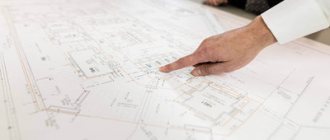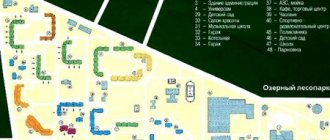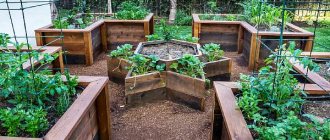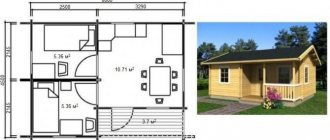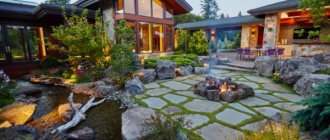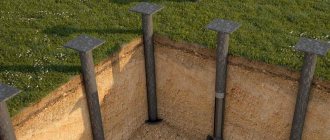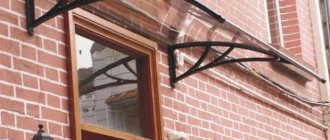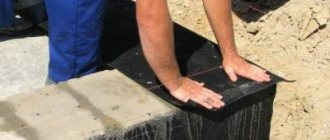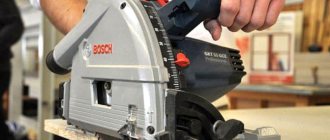When buying a plot of land, you should be prepared for the fact that it will have to be leveled. After all, building a house, laying out a lawn or laying out beds requires a smooth, even surface. Only a slight slope in a southerly direction is appropriate.
Brief overview of the article
- Why is land leveling necessary?
- Preparatory stage
- How can you level your dacha area?
- Manual leveling
- Leveling with a walk-behind tractor
- How to level the ground with a tractor
- Leveling with imported soil
- Features of leveling territory with a slope
- Useful tips
- Recommendations for replenishing soil fertility
- Photo of the land plot
Why is land leveling necessary?
Leveling a plot at your dacha means manipulating the soil, giving the landscape the desired relief. Below are the main possible reasons for making the soil cover even:
- Development. The foundation requires a perfectly flat surface. If the site is located on a slope, you will have to organize additional delivery of earth to level it.
- Arrangement of paths. It is easier to make a path out of asphalt or cover it with tiles if the ground surface is smooth.
- Laying out a garden or vegetable garden. In this case, leveling helps to avoid uneven distribution of moisture in the soil.
- Creating a lawn. A flat surface promotes better establishment of the lawn mixture, a more beautiful and healthy appearance of the green area, and also simplifies its care.
- Decorative arrangement of the territory. The implementation of most design ideas requires a leveled area.
Non-standard situations
If the site is initially located on a large slope, then during the leveling process it can be transformed into a multi-tiered area, instead of flat land, but at an angle. The principle of operation is the same, but preliminary sectorization must be done not only by squares, but also by levels, if you decide to do the work yourself.
Site located on a slope
Each tier is leveled separately, but it is important that they are parallel to each other. The distance between them and their number is calculated based on the vertical distance between the lowest and highest points on the site. For example, if the height of the slope is approximately 80 centimeters, then you can make two tiers with a distance between them of 40 cm or three, but with a distance of 25 cm. During the operation of construction equipment, a special drive must be arranged for each tier.
Leveling the land in tiers
The resulting gap levels can be beautifully lined with stones, with several small paths between them. You can also arrange a mini-waterfall or just a stream. But they should be sealed for greater reliability. For example, protect stones from the soil with waterproof fabric.
Transitions between tiers decorated with stones
With such a layout, residential buildings must be erected at the highest level.
A multi-tiered suburban area will be a rather unusual solution, and will also solve the problem of the general slope of the territory. Plus, it will look quite unusual, delighting both guests and hosts with its appearance
Multi-tiered summer cottage
Along with standard leveling in a dacha area, the relief can be artificially distorted. For example, build a mountain or a depression under a body of water. This method and feature of leveling for a summer cottage will be a very original solution. Thanks to it, it will be possible to give the dacha a more natural and pristine look, as if the mountains or depressions were created by nature itself, and not by man.
Artificial mountain with a pond on the site
Preparatory stage
Before leveling the area, it is necessary to carry out the following work:
- Using pegs and rope, mark the boundaries of the area that needs leveling. If manual leveling work is expected, it is recommended to divide the territory into sectors.
- Remove all debris from the surface of the plot of land, mow down the weeds, and uproot large roots.
- Remove unnecessary objects - dead trees, bushes, unused structures and decorative details.
Expenses
It is more efficient to process large areas (from five hectares) by ordering the appropriate services from the appropriate organization. Professionals will do the job better and more accurately. For example, using a cultivator. The cost of such a service will vary in different regions. The condition of the surface of the land also influences the price.
Thus, the average rental price for special equipment varies from 1.5 to 2 thousand. And calling a consulting specialist and his services costs from 2.5 to 4.5. Removal of trees, bushes, and stumps will cost about 500 rubles on average. You will have to pay for leveling the site depending on its size - the number of square meters.
These are approximate prices, to which, if you order site leveling from a company, you should add payment for soil fillers and various expenses, for example, transportation costs. It is cheaper to level a summer cottage yourself, spending less money on consultation and rental of special equipment.
- How to make a modern landscape design with your own hands?
Microgreens at home
Purpose and types of thickness gauges
Manual leveling
This method is advisable to use only for owners of small plots. It requires significant time and effort, but allows you to save on equipment.
There are two options to speed up work:
- hiring workers;
- help from acquaintances and friends.
To level the area with your own hands, you need to stock up on the following tools:
- Shovel. You need two of them - bayonet and scoop type.
- Garden cart
- Fan rake.
- Lumber.
- Level gauge.
Algorithm of actions:
- Mark the territory.
- Remove 10-20 cm of turf, pack it in bags, take the load to the border of a private household so that it is not in the way, and lay it out. Provide the removed soil with access to oxygen, i.e., put it out of bags.
- Level the area, controlling the horizontality with a building level. For this purpose, hammer in pegs throughout the site and tighten the ropes.
- Fill holes using the removed soil. Remove excess soil. If there is a shortage of fertile land, purchase it.
- Compact the surface of the area. In this case, it is permissible to use a hand roller, a wooden ladder or planks, having previously attached them to the soles of shoes.
- Water the leveled area generously. Wait 21 days - the earth should settle.
- Plow with a cultivator and level with a rake.
Leveling the ground: turn to specialists or do it yourself
Of course, the answer to this question lies on the surface. If the owner of the site has sufficient funds, then the easiest way is to contact specialists and quickly solve the problem. It is also better to hire them if the dacha plot is swampy, has significant unevenness, slopes, a lot of stones, etc., here you most likely cannot do without special equipment. Such a site will require the use of a bulldozer, tractor and cultivator.
Note! In most cases, almost all work on the local area can be done with your own hands in a short time. As a rule, the best option for work may be the combined use of the services of specialists (in terms of performing heavy work) mixed with your own work.
Leveling with a walk-behind tractor
To speed up and simplify the procedure for smoothing out uneven areas, you can rent any small-sized agricultural device, for example, a walk-behind tractor - a compact hand tractor.
It is not difficult to use - a person follows the unit, controlling the progress of work using control levers. The advantage of a walk-behind tractor is that there is no need to remove the top layer of soil. The disadvantage is that large holes will have to be filled with a shovel.
The order of steps is as follows:
- Attach the boards to the special holder of the hand tractor.
- Align the area into sectors. The walk-behind tractor will loosen the soil, and the board will level it.
Getting rid of everything unnecessary
Before you begin leveling the soil layer itself, it is necessary to remove all debris and rubbish: remnants of building materials, waste, stones, trees and branches, plants. You can do this yourself or order the services of special services.
It is most convenient to remove excess from the site in the spring, after the snow and water have melted and the top layer of soil has dried out a little.
How to level the ground with a tractor
Photos of a level area clearly show the effectiveness of leveling with a tractor. But this is an expensive procedure, because you will have to pay a lot of money to hire a specialist and rent equipment.
Instructions on how to level a site with a tractor include two steps:
- Passage of equipment along the entire site.
- Transverse cultivation of the territory with equipment.
The tractor is equipped with a special type of teeth. They provide deep loosening of the soil and dragging layers of earth. The bucket allows you to move a significant volume of soil.
No. 1. Types of rolled lawn
Rolled lawn makes it possible to create an ideal grass surface almost anywhere in the shortest possible time, which is its main advantage. It has found application in various fields, so today it is customary to distinguish the following main types of rolled turf:
- ground floor It is distinguished by the highest decorative qualities, it has a uniform color, velvety surface, and is very dense. The main disadvantage is sensitivity to excess moisture, lack of sun and other factors. This is a very capricious coating that is used to decorate the local area. Walking on such a lawn is strictly prohibited - it will not tolerate such exposure. At the dacha, it can only be used to decorate flower beds, but it will require specific care;
- sports turf is intended for arranging football fields, sports grounds and other areas with high loads. The cover consists mainly of grasses such as ryegrass and bluegrass. This mixture is very resistant to trampling and other negative factors, but this does not mean that you do not need to care for such a lawn. It can be used to organize a children's playground in the country;
- the universal lawn has gained the greatest popularity. This is what is used in dachas, because it resists various weather factors well and can withstand active loads, so you can run on it without problems. You can use the lawn almost anywhere, and at the dacha it will become both a decoration for the site and a place for a picnic.
Features of leveling territory with a slope
If the land plot has a large slope, it is recommended to solve the leveling issue using more creative methods. The most aesthetically attractive way is to form terraces. Their number and configuration will depend on the size and shape of the territory.
The vertical walls of the steps can be lined with stone or decorated with climbing crops. Some enthusiasts let out small cascade streams.
Feasibility
Leveling the site before sowing lawn grass mixture is necessary, since the presence of unevenness will lead to the following undesirable consequences:
- the lawn loses its attractiveness;
- bald spots appear: seeds are washed away by rain from highlands to lowlands;
- When watering, water stagnates in lowlands, causing the grass to become sick;
- the haircut is done unevenly: in the lowlands it is too long, in the hills it is almost “zero”. If there are significant differences in height, cutting is generally impossible - there is a risk of damaging the lawn mower;
- injury hazard. When children frolic in outdoor games, they often run onto the lawn, and if it is strewn with bumps, falls are inevitable.
They also resort to leveling the site if it is planned to:
- setting up a vegetable garden;
- pool installation;
- building a house or fence.
At the same time, one should be aware of the high labor intensity of such work.
If you do not plan to create objects, it would be wiser to resort to an easier method:
- hide unevenness by planting a flower bed;
- plant berry bushes, for example, currants: this will also make the relief less noticeable;
- beat up the irregularities by arranging a decorative pond, a rock garden, or a corner decorated in a fairytale style.
Useful tips
If you decide to level the territory of your dacha yourself, study the following tips:
Before you begin to implement measures to adjust the landscape, you need to decide on the functions of individual zones. Familiarization with the site plan and consultation with professionals in the field of land works will help you avoid making mistakes in zoning. It is also necessary to clarify the direction of water flow and the slope of the terrain.
Since leveling involves moving the soil, you need to evaluate in advance the complexity of such an action. This way it will be possible to understand whether the use of special equipment will be required or whether you can limit yourself to manual labor.
Possible storage time for removed turf is 30 days. Then the aerobic microorganisms will die and the soil will no longer be usable.
Work on leveling the site must be completed before the construction of buildings, laying out paths and laying pipes begins. The optimal time for their production is autumn.
Large areas should be leveled using equipment specially designed for this purpose.
Preparation and planning
The first stage of preparation for leveling the soil is removing debris. First, construction waste is removed. It is important to know that it should be transported to specially designated places. Next, the area is cleared of stones. Now it’s the turn of stumps, weeds and the root systems of various plants. After this work is completed, you need to let the area stand for a week. It will be good if the weather is sunny at this time.
Now you need to do a little marking: divide the territory into 9 equal parts. Markings are made using pegs. Now we take the rope and stretch it on a peg at a distance of 10 cm from the surface of the earth. We carefully examine the territory and fill in the holes; the mounds need to be leveled. If there is not enough soil on the territory, then it is purchased additionally. You should also examine the composition of the soil before leveling. If the soils are infertile, then good soil should be created artificially by purchasing the required amount of fertile soil.
Recommendations for replenishing soil fertility
In most cases, the procedure for making a site horizontal involves removing the top fertile layer of soil.
If you notice that the depth of the nutrient turf has become less than 20 cm, it means that fertility needs to be restored using peat humus soil mixture. The ordered soil must be distributed as evenly as possible over the leveled area.
When purchasing, you should consider the structural structure of the soil. If the site has clay or loam, they need to be diluted with fertile soil mixed with sand. And ash and lime are an excellent means for neutralizing acidic soil.
Leveling the landscape requires time and effort. But a flat area for a lawn, building or vegetable garden will repay all the efforts invested.
Leveling up on time
The ideal time to start work is after the house has been completed, the communications system has been installed, and before paths are laid out on the site, decorations and recreational facilities are placed.
As for the seasons, it is best to level the area in the fall, since in the winter-spring period heavy rainfall and low temperatures will contribute to the shrinkage of the soil and saturate it with additional minerals and fertilizers. The latter will be a plus for gardeners and gardeners.
Photo of the land plot
Lawn care
Often, despite the measures taken, weed seeds sprout along with the lawn. Weeding can only be done by hand, pulling out each sprout by the roots. Of course, this should only be done on a dry area so that the soil does not stick to the soles of your feet. Do not delay weeding; if the weeds grow, their overgrown bushes, when pulled out, carry along the sprouts of lawn grasses, the surface becomes uneven and pitted. Rolling the area with a light roller will help correct the situation.
When the grass reaches a height of 7-8 cm, you can mow it. And then they begin the usual care - regular mowing in combination with watering and fertilizer, without which it is impossible to obtain a thick emerald carpet. However, all the efforts will very soon pay off with interest. A beautiful lawn will delight your household and become a source of pride for you.
↑ Laying lawn on a concrete surface
Sometimes a concrete foundation needs to be installed on a site. Most often these are the following areas: a children's playground, an open terrace, a balcony in an apartment.
Most often, the design of a concrete base is carried out only in certain areas.
To glue the synthetic coating to concrete, you will need a backing. This will make your lawn last a couple of years longer.
As a substrate, you can purchase geotextiles or rubber coating.
Before laying the covering, the concrete base is cleared of debris. Then lay out the required amount of substrate. After that - lawn grass in rolls. There must be an air cushion between the substrate and the coating.
It's good when the base is made of polyester. It is necessary to ensure that the layers overlap each other by approximately 15 mm.
After this, the substrate and the lawn should rest until completely straightened. Then the materials are glued together using polyurethane glue and connecting tape.
If the lawn covering is laid using the semi-fill or backfill method, then additional backfilling with quartz sand and rubber granules is required. All edges are decorated with small borders.
Tamping
Lawn preparation includes tamping. For future sowing of seeds, the soil must be compacted. Compact the dug up and leveled soil with a hand roller weighing approximately one hundredweight. Although you can use a simple board. No one should be allowed to roll the earth after or during rain. Walking on compacted and compacted soil is not allowed. Carefully compacted soil will allow the seeds to lie evenly in the ground, and this in turn will help them swell and sprout.
We have figured out how to compact the soil under the lawn, now let's move on to the next final stage.
Weed removal
To create lawns, special grasses are grown that delight the eye with rich colors and give pleasant tactile sensations
Any weed will spoil the impression, so it is important to get rid of extraneous vegetation
Two methods are used:
mechanical. The turf is cut to a shallow depth and stacked with the roots facing up. After six months, the cut soil is used as humus: it is free of weeds and rich in nutrients;
chemical. The area is treated with herbicides, for example, Roundup or Reglon. The poison affects the plants completely, penetrating through the aboveground part into the roots, so that after a few days the area becomes clean
When using pesticides, it is important to strictly follow the instructions, otherwise they may subsequently harm beneficial plants.
To avoid damage to lawn grass by the herbicide, sowing should begin no earlier than 6 weeks after treatment. During this period, weeding is carried out regularly, destroying the remaining weeds.
